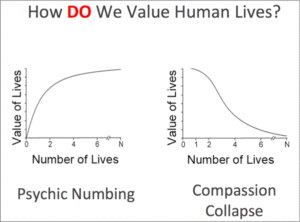Compassion fade
How much can we ever know about the love and pain in another heart? How much can we hope to understand those who have suffered deeper anguish, greater deprivation, and more crushing disappointments than we ourselves have known?
Orhan Pamuk

Source: Flickr
“A strong feeling of sympathy with another person’s feelings of sorrow or distress, usually involving a desire to help or comfort that person.” That is how American Psychological Association defines compassion. To suffer together, with the person in trouble. That is compassion, and as it seems, it is easy to fade.
Compassion fade is a cognitive bias, which refers to the decrease in the compassion one shows for the people in trouble as the number of the victims increase. It can be a result of psychic numbing, first put forth by Robert Jay Lifton. Psychic numbing makes us indifferent in the face of mass suffering. This picture, taken from here, clearly illustrates this phenomenon.

The works of Paul Slovic, professor of psychology at the University of Oregon, show that one of the best ways to combat indifference to mass suffering is to tell individual human stories, reminding the world that behind every number is a human.
Slovic, in his paper ‘Compassion fade and the challenge of environmental conservation’, argues that:
“A single child fallen down a well or dying of starvation stirs our hearts and moves our hands (and wallets) to action. Yet as soon as the number of victims increases to two, compassion—both affective and behavioral—begins to wane Such compassion fade (i.e., decreases in helping behavior or support for it) has been widely documented in the humanitarian domain and is troubling for at least three reasons. First, it defies our normative beliefs about how we should value the lives of those in need. Second, it contradicts our intuitions about how we ourselves would react when asked to aid others. Third, it suggests that confronting large-scale humanitarian and (perhaps) environmental crises—from mass starvation to climate change—may not only involve overcoming political and economic hurdles but also insidious psychological ones as well”
Also watch
Paul Slovic on Compassion fade
Further reading on compassion fade
Compassion Fade: Affect and Charity Are Greatest for a Single Child in Need
The Dragons of Inaction: Psychological Barriers That Limit Climate Change Mitigation and Adaptation
Shocker: Empathy Dropped 40% in College Students Since 2000
A psychologist explains the limits of human compassion
